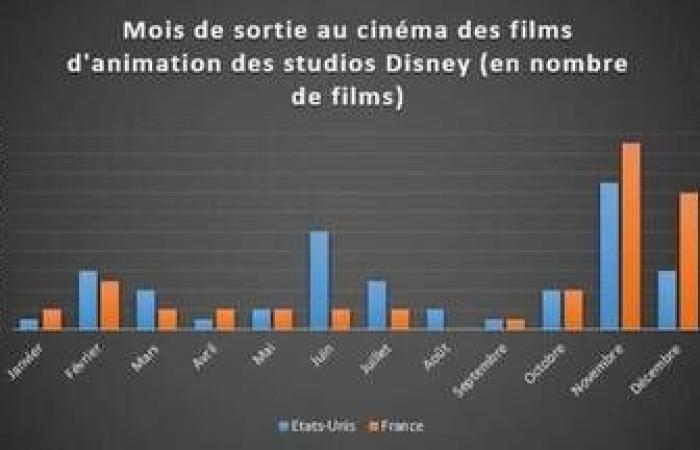By Lucie MériJEAU and Sébastien ROFFAT, doctors in cinematographic and audiovisual studies (Sorbonne Nouvelle University, Paris 3).
Going to see a “Disney Christmas” at the cinema is a tradition for many families during the end-of-year holidays. For 2024, it is Vaiana 2 which will take center stage from November 27, 2024. According to two researchers in film studies, this is a marketing strategy developed expressly for France in the 1950s by Disney.
Coco, Frozen 2, Encanto, Wish…This year it’s Vaiana 2 which is at the top of the bill for the holidays and from November 27, 2024. Going to see a Disney animated film for the Christmas holidays, what could be more natural for French families? Moreover, the expression “Christmas Disney” is well anchored in our vocabulary.
This “Christmas Disney” refers more to the film's release period than to the content itself: Walt Disney always avoided evoking typically American subjects or Christian themes in his cartoons. Thus, no short films feature the Thanksgiving holiday or the 4th of July, only one or two talk about Christmas and only one about Easter. And those who talk about Christmas are rather sad, like Mickey's Christmas (1983).
Marketing strategy since the 1950s
Releasing a “Disney at Christmas” is indeed a French specificity, a marketing strategy developed in the 1950s for our domestic market.
Some numbers first. Of the 56 great Disney animated classics released until 2016, nearly 70% had their French premiere between October and December, without counting the revivals. Indeed, all Disney films have been released several times in cinemas, like Snow White and the Seven Dwarfs (seven times): May 1938, December 1944, August 1951, December 1962, December 1973, November 1983 and February 1992.
This concentration of releases over the autumn period (37 films out of 56) is in reality a French specificity because the American market is smoother over the year although two peaks are observed: in the United States, the months of strongest film releases are November (15 out of 56) then June (10 out of 56) while in France it is November (19 out of 56) then December (14 out of 56). Recent years have not broken this rule with systematic releases of a film at the end of the year like the two parts of the Snow Queen, Coco, Charm or even Wish in 2023.
Different timing in the United States
The idea of releasing Disney animated feature films for Christmas was not immediately obvious. Snow White et Pinocchio were thus released in May during their first exploitation, Dumbo in October and Bambi in July.
During the second half of the 1940s, films were released in a relatively disorderly manner in cinemas (remember that the French only saw Snow White before the war and that during the German Occupation, the screening of American films was prohibited): Fantasia in November, Greetings Friends in February, The Three Caballeros in April, The Music Box in September, Naughty Spring a march, Cocktail Melody in February. Southern Melody is the first Disney feature film to be released in a concerted manner in December 1949 on French screens. After this date and with a few rare exceptions, all Disney films will be released in France for the Christmas holidays; a tradition that continues today.
More surprising for us who are used to simultaneous worldwide releases, if a Disney film was released in December in the United States, the French release took place in December of the following year (Merlin the Enchanter was released in the United States in December 1963 and in France in December 1964). Walt Disney had done everything possible to have his first animated feature film ready for Christmas 1937. Despite the studio's best efforts, Snow White and the Seven Dwarfs would not be released in American theaters until February 1938 (the world premiere did, however, take place in December).
The Americans actually concentrate outings on two particular periods of the year. First, Thanksgiving, the fourth Thursday in November (a public holiday in the United States since 1941), helps prepare the public for Christmas (products derived from the film bring in more money than the film itself) and prepares for a release. Very fast DVD for the end of the year: in the United States, there is no legal delay between the release of the film in theaters and its release on video, as is the case in France.
This Thanksgiving long weekend is therefore a prime time to release a Disney film. The other very popular period is June (10 out of 56 releases): Americans take advantage of the air conditioning in dark cinemas to escape the summer heat. We also notice that Disney films which are intended to be less “family” and intended for a more adult audience are also released during this period.
From Toy Story (March 1996 in France), an unwritten rule dictates that Pixar films be released far from the winter period and from Cars (in June 2006, a date coinciding with the acquisition of the studio by the Disney company), the films are only released in the summer. The studio's CG feature films do not target the same (family) audience as Disney films. Their stories and postmodern aesthetic are aimed at children as well as adults.
Read also: Why is Cotino, this mega-district built by Disney in the middle of the desert, so controversial?
A well-established tradition
The Disney Christmas in France, on the other hand, is a very deeply rooted “tradition”. At Christmas 1938, Snow White and the Seven Dwarfs is thus the first foreign film to be screened at the Élysée in front of 300 underprivileged children. It has long been unthinkable to release a Disney animated feature film during the summer holidays: the children are on vacation, at the beach or elsewhere.
The very long French summer break prevented the release of important films during this period for many years (the trend has been decreasing for several years but no Disney film has ever been released in August, for example). In France, the choice to release a feature film at Christmas became obvious from 1949. At this time, little French people had two weeks of vacation. Families come together in the enchanting spirit of Christmas and the tradition of going to the show is perpetuated through the cinema: going to the circus or seeing a puppet show is part of the same movement.
A commercial agenda
Releasing a film at Christmas also makes it possible to launch promotional campaigns in the summer and raise expectations among young audiences. The derivative products appear on the shelves even before the film is released in theaters.
The release of a Disney film at Christmas also allows Disneyland Paris to benefit from a synergy effect because the November-February period corresponds to the low season: however, a release too late in the year does not leave enough time for the parks to organize themselves nor for the public to immerse themselves in the songs. Thus, the indestructible spectacle around The Snow Queen at Disneyland Paris began well after the film was released in theaters.
Read also: Disneyland Paris celebrates its 30th anniversary, here are seven things to know about the famous amusement park
The influence of TV shows
We must not neglect the importance of television in the construction of this idea of “Christmas Disney”. The deployment of the Disney universe and the association between “Disney films” and “Christmas time” had their origins at the end of 1961 in the children’s show L’Ami public number one.
The program, presented by Pierre Tchernia, exemplifies the Disney company's desire to collaborate “to improve relations between the cinema and television industries”. This show, broadcast from 1961 to 1978 on the first ORTF channel then on TF1, offered new short films as well as “classic” feature films from the American studio.
The SVP Disney show was broadcast between 1964 and 1978, on Christmas Day. A list of films was offered at the start of the program so that viewers could choose the extracts they wanted to see broadcast, by calling the “SVP” number.
Throughout these fourteen years, a veritable horizon of expectation has been created for millions of viewers, young and old, with the promise that every Christmas, they would be able to interact with their favorite characters. This practice of broadcasting Disney at Christmas has never stopped, whether we think of the special programs presented by Jean-Pierre Foucault in the 1990s or the feature films broadcast by the channels each year.

“Christmas Disney” has become a must, especially since for decades there was no serious competitor in this profitable niche. Finally, let us add that the Walt Disney Company France could keep a film in reserve for weeks or even months before deciding to release it for Christmas: before the emergence of the internet, there was no risk of piracy or “spoilers” . From now on, the releases of major films are simultaneous in all territories, which explains why from the 2000s, certain Disney feature films are released at a time other than Christmas, which does not prevent their success.
The original version of this article was published in The Conversation.
![]()









